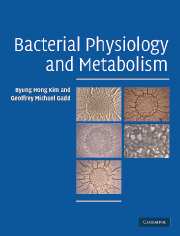Book contents
- Frontmatter
- Contents
- Preface
- 1 Introduction to bacterial physiology and metabolism
- 2 Composition and structure of prokaryotic cells
- 3 Membrane transport – nutrient uptake and protein excretion
- 4 Glycolysis
- 5 Tricarboxylic acid (TCA) cycle, electron transport and oxidative phosphorylation
- 6 Biosynthesis and microbial growth
- 7 Heterotrophic metabolism on substrates other than glucose
- 8 Anaerobic fermentation
- 9 Anaerobic respiration
- 10 Chemolithotrophy
- 11 Photosynthesis
- 12 Metabolic regulation
- 13 Energy, environment and microbial survival
- Index
- References
13 - Energy, environment and microbial survival
Published online by Cambridge University Press: 05 September 2012
- Frontmatter
- Contents
- Preface
- 1 Introduction to bacterial physiology and metabolism
- 2 Composition and structure of prokaryotic cells
- 3 Membrane transport – nutrient uptake and protein excretion
- 4 Glycolysis
- 5 Tricarboxylic acid (TCA) cycle, electron transport and oxidative phosphorylation
- 6 Biosynthesis and microbial growth
- 7 Heterotrophic metabolism on substrates other than glucose
- 8 Anaerobic fermentation
- 9 Anaerobic respiration
- 10 Chemolithotrophy
- 11 Photosynthesis
- 12 Metabolic regulation
- 13 Energy, environment and microbial survival
- Index
- References
Summary
As mentioned repeatedly in this book, the goal of life is preservation of the species through reproduction, but this requires energy. Although there are a few exceptional copiotrophic environments such as foodstuffs and animal guts, most ecosystems where microorganisms are found are oligotrophic. Those organisms that can utilize nutrients efficiently have a better chance of survival in such ecosystems. Further, many microbes synthesize reserve materials, when available nutrients are in excess, and utilize these under starvation conditions, while various resting cells are produced under conditions where growth is difficult. In this chapter, the main bacterial survival mechanisms are discussed in terms of reserve materials and resting cell types.
Survival and energy
As discussed earlier, living microorganisms maintain a certain level of adenylate energy charge (EC) and proton motive force even under starvation conditions (Section 5.6.2). These forms of biological energy are needed for the basic metabolic processes necessary to survive such as transport and the turnover of macromolecules. Maintenance energy is the term used for this energy.
Under starvation conditions, cells utilize cellular components including reserve and non-essential materials for survival. This is referred to as endogenous metabolism. Almost all prokaryotes accumulate at least one type of reserve material under energy-rich conditions. During a period of starvation, the reserve material(s) are consumed through endogenous metabolism before the organism oxidizes other cellular constituents such as proteins and RNA that are not needed under the starvation conditions (Figure 13.1).
- Type
- Chapter
- Information
- Bacterial Physiology and Metabolism , pp. 482 - 495Publisher: Cambridge University PressPrint publication year: 2008
References
- 1
- Cited by

